Antibody data
- Antibody Data
- Antigen structure
- References [1]
- Comments [0]
- Validations
- Immunocytochemistry [3]
- Immunohistochemistry [4]
- Flow cytometry [2]
- Other assay [1]
Submit
Validation data
Reference
Comment
Report error
- Product number
- MA5-32221 - Provider product page

- Provider
- Invitrogen Antibodies
- Product name
- ATG7 Recombinant Rabbit Monoclonal Antibody (SC06-30)
- Antibody type
- Monoclonal
- Antigen
- Synthetic peptide
- Description
- Recombinant rabbit monoclonal antibodies are produced using in vitro expression systems. The expression systems are developed by cloning in the specific antibody DNA sequences from immunoreactive rabbits. Then, individual clones are screened to select the best candidates for production. The advantages of using recombinant rabbit monoclonal antibodies include: better specificity and sensitivity, lot-to-lot consistency, animal origin-free formulations, and broader immunoreactivity to diverse targets due to larger rabbit immune repertoire.
- Reactivity
- Human
- Host
- Rabbit
- Isotype
- IgG
- Antibody clone number
- SC06-30
- Vial size
- 100 μL
- Concentration
- 1 mg/mL
- Storage
- Store at 4°C short term. For long term storage, store at -20°C, avoiding freeze/thaw cycles.
Submitted references lnc-HOTAIR predicts hepatocellular carcinoma in chronic hepatitis C genotype 4 following direct-acting antivirals therapy.
El-Khazragy N, Elshimy AA, Hassan SS, Shaaban MH, Bayoumi AH, El Magdoub HM, Ghozy S, Gaballah A, Aboelhussein MM, Abou Gabal HH, Bannunah AM, Mansy AE
Molecular carcinogenesis 2020 Dec;59(12):1382-1391
Molecular carcinogenesis 2020 Dec;59(12):1382-1391
No comments: Submit comment
Supportive validation
- Submitted by
- Invitrogen Antibodies (provider)
- Main image
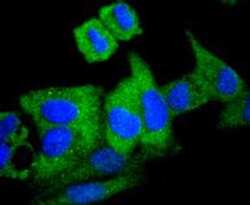
- Experimental details
- Immunocytochemical analysis of ATG7 in Hela cells using a ATG7 Monoclonal antibody (Product # MA5-32221) as seen in green. The nuclear counter stain is DAPI (blue). Cells were fixed in paraformaldehyde, permeabilised with 0.25% Triton X100/PBS.
- Submitted by
- Invitrogen Antibodies (provider)
- Main image
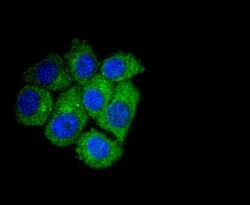
- Experimental details
- Immunocytochemical analysis of ATG7 in HepG2 cells using a ATG7 Monoclonal antibody (Product # MA5-32221) as seen in green. The nuclear counter stain is DAPI (blue). Cells were fixed in paraformaldehyde, permeabilised with 0.25% Triton X100/PBS.
- Submitted by
- Invitrogen Antibodies (provider)
- Main image
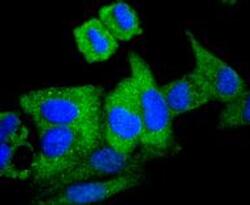
- Experimental details
- Immunocytochemical analysis of ATG7 in Hela cells using a ATG7 Monoclonal antibody (Product # MA5-32221) as seen in green. The nuclear counter stain is DAPI (blue). Cells were fixed in paraformaldehyde, permeabilised with 0.25% Triton X100/PBS.
Supportive validation
- Submitted by
- Invitrogen Antibodies (provider)
- Main image
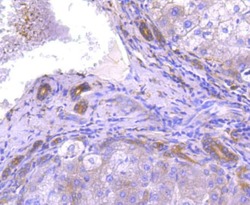
- Experimental details
- Immunohistochemical analysis of ATG7 of paraffin-embedded Mouse brain tissue using a ATG7 Monoclonal antibody (Product #MA5-32221). Counter stained with hematoxylin.
- Submitted by
- Invitrogen Antibodies (provider)
- Main image
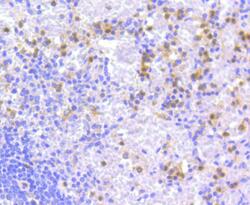
- Experimental details
- Immunohistochemical analysis of ATG7 of paraffin-embedded Human spleen tissue using a ATG7 Monoclonal antibody (Product #MA5-32221). Counter stained with hematoxylin.
- Submitted by
- Invitrogen Antibodies (provider)
- Main image
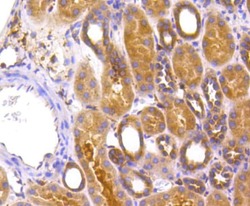
- Experimental details
- Immunohistochemical analysis of ATG7 of paraffin-embedded Human kidney tissue using a ATG7 Monoclonal antibody (Product #MA5-32221). Counter stained with hematoxylin.
- Submitted by
- Invitrogen Antibodies (provider)
- Main image
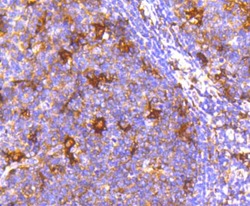
- Experimental details
- Immunohistochemical analysis of ATG7 of paraffin-embedded Human tonsil tissue using a ATG7 Monoclonal antibody (Product #MA5-32221). Counter stained with hematoxylin.
Supportive validation
- Submitted by
- Invitrogen Antibodies (provider)
- Main image
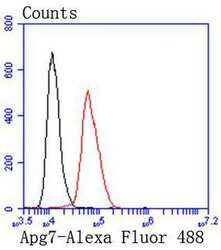
- Experimental details
- Flow Cytometric analysis of ATG7 in Hela cells using a ATG7 Monoclonal Antibody (Product # MA5-32221) at a dilution of 1:50, as seen in red compared with an unlabelled control (cells without incubation with primary antibody; black). Alexa Fluor 488-conjugated goat anti rabbit IgG was used as the secondary antibody.
- Submitted by
- Invitrogen Antibodies (provider)
- Main image

- Experimental details
- Flow Cytometric analysis of ATG7 in Hela cells using a ATG7 Monoclonal Antibody (Product # MA5-32221) at a dilution of 1:50, as seen in red compared with an unlabelled control (cells without incubation with primary antibody; black). Alexa Fluor 488-conjugated goat anti rabbit IgG was used as the secondary antibody.
Supportive validation
- Submitted by
- Invitrogen Antibodies (provider)
- Main image
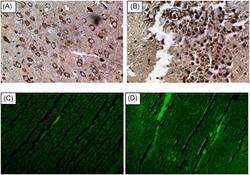
- Experimental details
- 4 Figure Immunohistochemically staining of ATG-7 protein in HCC following DAAs therapy in HCV patients the representative image shows the proportion of ATG-7 staining immune-positive cells; (A) 20%-40% HCC-positive cells in patients with lnc-HOTAIR expression levels
 Explore
Explore Validate
Validate Learn
Learn Western blot
Western blot Immunocytochemistry
Immunocytochemistry